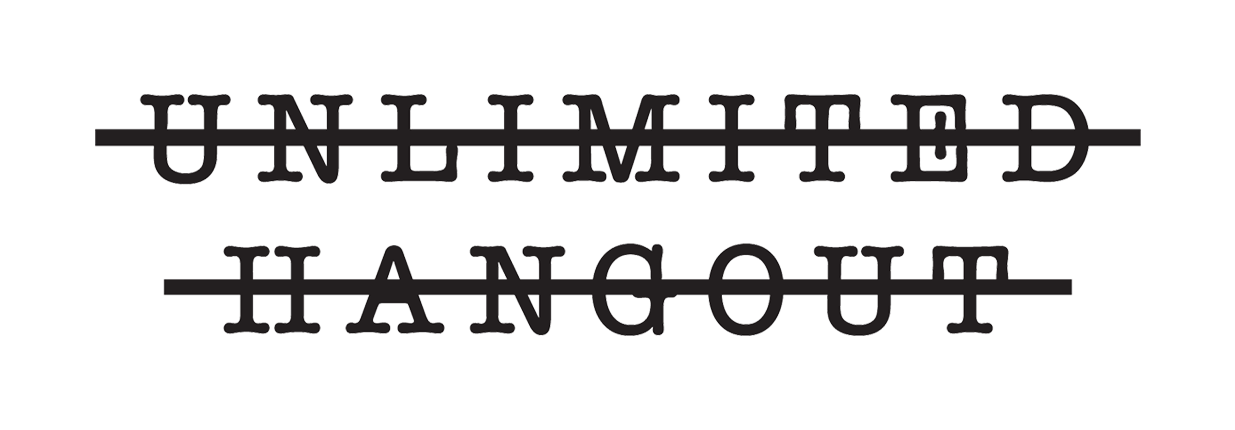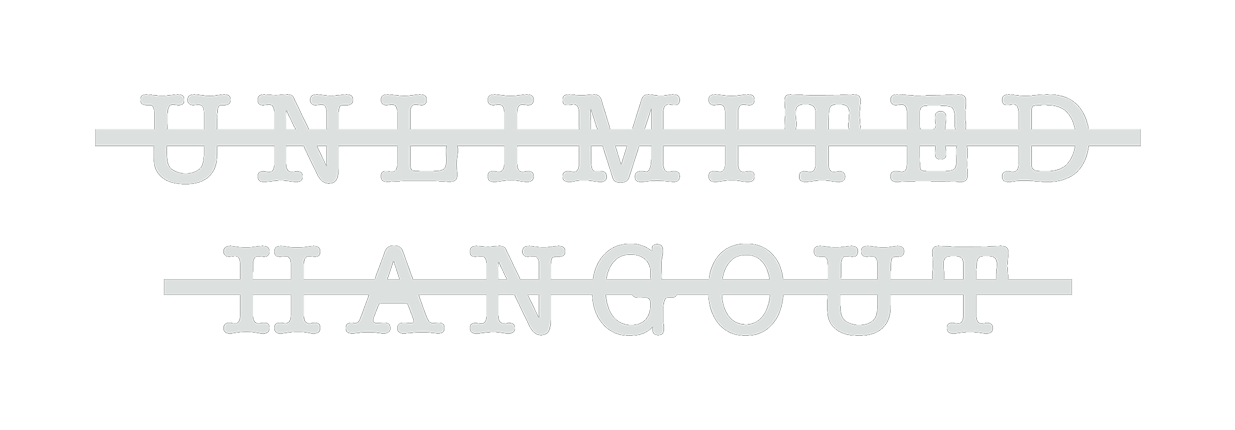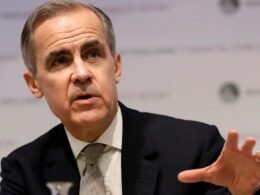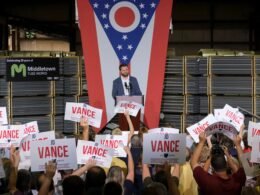Guido Goldman, the founder and driving force behind the German Marshall Fund, was the son of Nahum Goldmann, one of the most influential Zionist leaders in history who was central to the creation of the modern state of Israel. While Guido Goldman took great pains to distance himself publicly from his father’s legacy, throughout the late-60s, events in the Middle-East and Eastern Europe led to Goldman retreading in his father’s historical footsteps, helping to significantly influence major geopolitical events. The German Marshall Fund (GMF), as well as other powerful organizations Goldman has helped found, continue to wield considerable power and influence on the global stage.
In this article, we will investigate Guido Goldman’s German Marshall Fund and discover how one group of Establishment men, almost all of them high ranking members of the Council on Foreign Relations (CFR), created leadership programs, funded political propaganda for broadcast on various forms of mainstream media, and infiltrated positions within government.
High ranking members of the CFR had previously established a Harvard based program for training potential international young global leaders through Kissinger’s International Seminar. But when the Harvard seminar was exposed in 1967 as being CIA-funded, the influential CFR members involved began creating a new and improved iteration of the scheme, carefully crafted to meet very similar ends. Just as Kissinger’s seminar had originally been the brainchild of CFR bigwig William Yandell Elliot, the new and improved program was also the work of another top man at the CFR, Guido Goldman.
However, Guido Goldman wasn’t only a Harvard grandee, a high-ranking CFR member and the head of one of the most well-connected intellectual think tanks in the US, he and the GMF also had well concealed but incontrovertible links to the US Central Intelligence Agency.
Guido Goldman and the German Marshall Fund
Guido Goldman’s father, Nahum Goldmann is an extremely complex historical figure. Born in 1895, Nahum Goldmann spent the first 6 years of his life in the Russian Empire, within modern-day Lithuania. Nahum’s father, Soloman Hirsch Goldmann, was an ardent Zionist who took his son to such events as the Tenth Zionist Congress in 1911. Two years later, Nahum visited Palestine and at the age of 18, he published his early work Erez-Israel: Reisebriefe aus Palästina (Eretz Israel: Travel Letters from Palestine). Just two years after writing this latter piece of light reading, Goldmann published a much more serious book entitled, ‘Der Geist des Militarismus’ (The Spirit of Militarism). A year later, he began working for a German intelligence and propaganda bureau linked to the German Foreign Office. The Nachrichtenstelle für den Orient, as it was referred to in German, focused on exploiting ethnic and religious nationalist groups within the Ottoman Empire as a means of pushing back against the increasing British and French influence. Working for German intelligence taught Nahum Goldmann a lot, but his loyalty to Germany became undone with the rise of Nazism.

As Hitler rose to power, Nahum Goldmann dedicated all his free time to travelling the world in order to lobby the international community for the creation of a Jewish homeland in Palestine. This left Guido and his older brother without their father’s attention, while his mother, Alice Goldmann, also showed little interest in raising her two sons as is mentioned in the biography, Guido Goldman: Transatlantic Bridge Builder. That book, written by one of Goldman’s former-students Martin Klingst, states:
“The Goldmann family was wealthy, and their son Guido, as he himself acknowledges, led a life of privilege in New York. However, his parents took little interest in their two sons. Nahum Goldmann’s passions were exclusively directed toward politics, and his own political trajectory; Alice Goldmann was largely preoccupied with herself. Despite this parental self-absorption and the absence of love, Goldman said he largely survived unscathed, ascribing this above all to the care shown to him by Ruth, his Barbadian nanny.”
Klingst’s biography of Goldman claims that, unlike his father, Guido Goldman had “no specific political aim and no political program. What he did have was a keen sense for what matters.” But, as we will see, this latter quote was very far from the truth. By the time Guido Goldman was a young man, Nahum Goldmann had succeeded in helping to create the state of Israel. Nahum played a pivotal role in the founding of the Jewish homeland, having been instrumental in every part of the lobbying, planning and the creation of state we know today. Guido Goldman had big boots to fill and he became intent on forging his own legacy.
Guido Goldman was brought up surrounded by the Establishment, with the Goldmann residence in New York being a veritable thoroughfare for the American elite. Many famous international and American politicians, philosophers, socialites and others, came to bend the knee in honour of Nahum Goldmann, who they all recognized as one of the founding fathers of modern Israel. Visitors to the residence included Pianist Arthur Rubinstein, philosopher Isaiah Berlin, Seagram’s Samuel Bronfman, and Israel’s first president Chaim Weizmann. Politicians who were intricately involved with the creation of the United Nations also frequented the Goldmann household. The UN Secretary General Dag Hammarskjöld and influential figure at the early UN, Eleanor Roosevelt, were regular visitors. Herbert Lehman, who was a Democratic politician and co-owner of Lehman Brothers, was another influential friend of the family.
The Goldmann’s bustling house eventually saw the first Chancellor of West Germany visit. When Guido was 14 years old, his father had travelled to London to meet with the West German Chancellor Konrad Adenauer in his capacity as president of the Conference on Jewish Material Claims against Germany. There, he received the statement from Adenauer which read: “The honor of the German people requires it to do all it can to compensate the Jewish people for the injustice done to it.” Nahum Goldmann had not only helped to create Israel, he was also a key part in the reparations process between Germany, the Jewish people and the State of Israel itself.
The similarities between the legacy of Nahum Goldmann and what Guido Goldman was to go on to achieve with the German Marshall Fund are glaring. Nahum Goldmann was a very influential man and that influence was to be regularly utilised by Guido Goldman whenever it was required. In the book, “The Seventh Million: The Israelis and the Holocaust”, author Tom Segev writes of some of the negotiations in which Nahum was involved in during this period, stating:
“When the Israeli and Jewish representatives walked out of the formal negotiations, Nahum Goldmann’s great hour as a lobbyist and manipulator began. Goldmann organized and coordinated a worldwide network of activities aimed at persuading the Germans that it was in their best interests to reach an agreement. As part of this effort, he monitored, and even took part in, the ceaseless haggling in Bonn. He went to see cabinet ministers, senior officials, and members of parliament, making his way through the corridors of power and into the inner chambers. He saw everything and heard everything. He plotted intrigues. He shared secrets with supporters, thwarted opponents, collected promises, made threats: a man of a thousand faces.”

Nahum Goldmann was a legendary negotiator and his son, Guido Goldman, was ready to walk in his father’s footsteps. In Nahum Goldmann’s 1978 book, “The Jewish Paradox”, Goldmann speaks of the many Jewish statesmen he had become close to throughout his life stating: “I have had the privilege of knowing several Jewish statesmen personally—men like Léon Blum, Henry Kissinger, Pierre Mendès France, Bruno Kreisky and others—and good patriots as they have been and are in their respective countries.” One of those aforementioned statesmen in particular was a great influence on and guide to his son Guido.
Guido Goldman attended Harvard University, where he came under the tutelage of the future Secretary of State, Dr. Henry Kissinger. Described in a 2020 New York Times article as: “A Kissinger protégé,” Goldman graduated from Harvard in 1959 with a degree in government, earning his doctorate in the same field around a decade later. By this time, he had also dropped the extra ‘n’ on his surname. These were vital years, not only in Guido Goldman’s development but also in the history of Harvard projects such as Kissinger’s International Seminar, which had been busy training American-aligned potential young global leaders such as the future 15th Prime Minister of Canada Pierre Trudeau, the World Economic Forum’s lifetime leader Klaus Schwab and the eventual President of France Valéry Giscard d’Estaing.
Guido’s association with the Kissinger family had begun long before Guido attended Harvard. In fact, Goldman’s previously mentioned biography states: “Kissinger’s father, a high school teacher, was unable to find a job in a city very foreign to him; his mother, Paula, the daughter of a wealthy Jewish cattle dealer from Franconia, earned money in domestic service. Her employers included the Goldmanns: she was called whenever the Goldmanns invited many Jewish guests for dinner. Her job was to make sure the food was cooked in a correctly kosher manner, and that the organization of the meal went smoothly.”
Just like his father, Guido Goldman led some extremely influential organizations. Goldman co-founded the West European Studies program—which was soon renamed the Center for European Studies (CES)—at Harvard in 1969, with the first three years of funding supplied by the Ford Foundation. Goldman went on to serve as its director for twenty-five years. Kissinger had installed Abby Collins as Guido’s assistant at the CES and she stayed alongside Goldman for decades to come. Collins had been running Kissinger’s International Seminar, until Harvard’s Humphry Doermann’s report in 1967 exposed the program’s secret CIA funding. Goldman also incorporated the John F. Kennedy Scholarship into the CES, a program which allowed young German scholars to study at Harvard for a year. Today, the scholarship’s endowment is over $15,000,000. The Western European Studies program had another vital founder, Stanley Hoffmann, who was one of the biggest influences on Guido Goldman’s life. Hoffmann had taught Goldman at Harvard, where he was his academic supervisor as well as his mentor. Hoffmann was the son of an Austrian mother and an American father who had studied in Paris after the war. In 1955, Hoffmann moved to the US after being offered a position at Harvard. Goldman was 9 years younger than Hoffmann, but they soon became thick as thieves.
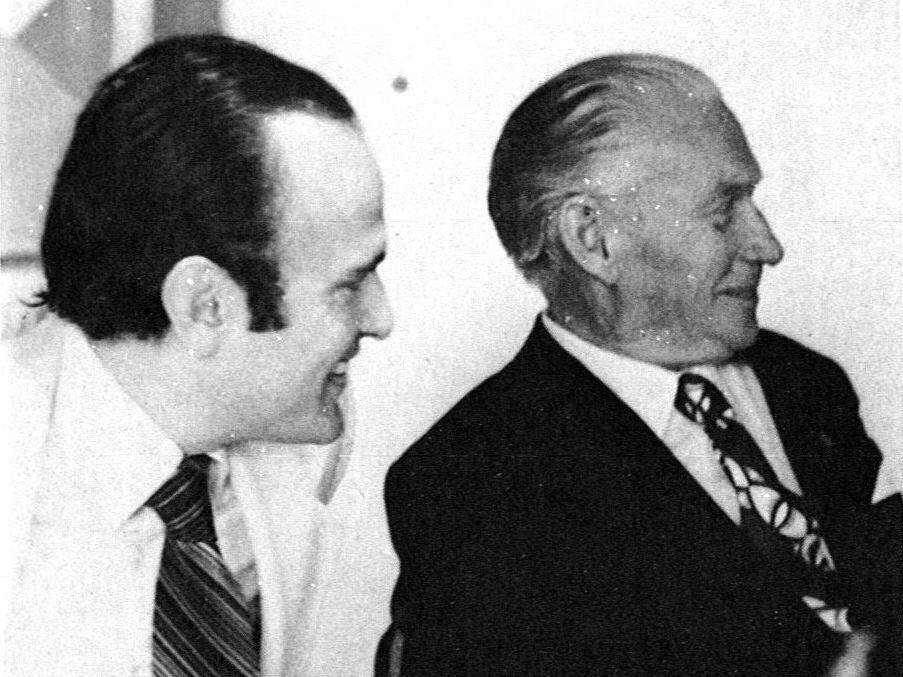
The prestigious Harvard Center for European Studies was by no means the only organisation of influence which Guido Goldman helped found. He also had a hand in creating the American Institute for Contemporary German Studies at John Hopkins University; the American Council on Germany based out of New York; as well as founding the John McCloy Scholarship Program at Harvard. Exactly like his father before him, Guido Goldman was an expert in the art of political manoeuvring. By far, the most important organization which Guido Goldman founded and guided would become critical to how the “deep state” wields its hidden power to manipulate public policy and overthrow governments. Today, the German Marshall Fund of America (GMF) is considered to be a non-partisan American public policy think tank and grant-making organization for fostering cooperation between North America and Europe, but on closer examination, it is actually a significant cog in the CFR’s soft-coup machinery. The Council on Foreign Relations is not merely a think tank created to map out potential future scenarios, it is an organization inextricably linked with the American intelligence agencies and the US national security apparatus.
The German Marshall Fund got its name from The Marshall Plan—the post-World War II program which saw the United States supply Europe with a significant aid package intended to help reconstruction efforts in Europe. At the time of the GMF’s founding, Guido Goldman was the director of Harvard’s Center for European Studies program. During this period, the famous university had grown to be much more than just a prestigious educational establishment, it had become a launch pad for a new array of post-war political programs and agendas led by influential power-brokers such as Henry Kissinger, John Kenneth Galbraith and William Yandell Elliott. The Marshall Plan had also originally been offered to Europe at a Harvard event, during a speech delivered by General George C. Marshall which his special assistant, Charles E. Bohlen, had written. The speech was delivered on 5 June 1947 at the steps of Memorial Church in Harvard Yard.
Twenty-five years to the day after the announcement of the Marshall Plan, Willy Brandt, the then-Chancellor of West Germany, took to the stage of the Sanders Theatre during a meeting which was officially called the “Harvard Marshall Memorial Convocation.” There, he announced that: “150 million West German marks would be given in equal instalments over the next 15 years for the establishment and operation in this country of an independent, American-run educational foundation specializing in European problems,” with Brandt going on to say: “It is to be known as the German Marshall Fund of the United States – A Memorial to the Marshall Plan.” It was also announced in that meeting that the acting president in charge of the German Marshall Fund was to be Guido Goldman. The funds to create the GMF, which was reported to be around $47 Million—equivalent to over $335 Million considering inflation today—was given to Harvard alongside donations for other similar and related programs being created by and run from the university.

According to those involved, West Germany’s generous gift of funding for the GMF hadn’t been some sudden, unplanned gesture by Willy Brandt and his government. Guido Goldman had already been lobbying Germany’s then-finance minister, Alex Möller, to support the Center for European Studies (CES) at Harvard as early as 1970. Guido Goldman’s biography mentions Alex Möller’s previous links to Guido’s father, stating: “Alex Möller, a Social Democrat, was a friend of Nahum Goldmann, and a beneficiary of political favors from him. Möller and Guido Goldman’s father had met some years previously through a mutual friend and got on very well.” Goldman was reported by the Harvard Gazette as being “blown away” during a meeting in 1971 after the Germans had told Goldman that they would help “design the initiative.”
The article states:
“Goldman, astonished, inquired, ‘Could you tell me in what dimensions of financing you have in mind?’ Möller replied, ‘I have in mind a gift of 250 million marks’ — which was $65 million. In the end, $1 million of the gift went to the CES at Harvard and the rest went to fund the German Marshall Fund of the U.S., one of the most important trans-Atlantic organizations.”
This close relationship between Harvard University and the German state had been carefully cultivated in the aftermath of World War II. The university also gave a number of post-war chancellors honorary degrees including: Konrad Adenauer in 1955, Willy Brandt in 1963, Helmut Schmidt in 1979 and Helmut Kohl in 1990, as well as Angela Merkel. In fact, there are many historic links between Germany and Harvard, with their relationship dating as far back as at least 1869, when then-Harvard President Charles W. Elliot announced changes at the university that were modelled in part on the German system. The German Marshall Fund was intended to make Harvard a “key locus of U.S. and German relations.” For those with a keen understanding of European history and culture, Germany has always been considered by most as the literal and figurative beating heart of Europe.
Although it was announced in 1972 by Brandt, Guido Goldman had begun to form the GMF’s Board of Trustees earlier, during the autumn of 1971. He convinced some very powerful figures to work alongside him, including Harvey Brooks, the then-Harvard dean of the Division of Engineering and Applied Physics; Robert Ellsworth, former U.S. ambassador to NATO and then-Nixon aide; Thomas L Hughes, president of the Carnegie Endowment for International Peace and Assistant Secretary of State for Intelligence and Research during the Kennedy and Johnson administrations; Richard N Cooper, professor of international economics and provost-designate at Yale University, who served in the Johnson and Carter administrations, later becoming chair of the National Intelligence Council during the Clinton administration; Max Frankel, the New York Times Washington bureau chief; and Howard R Swearer, the president of Carleton College and employee of the Ford Foundation. These six men became the members of the German Marshall Fund’s initial Planning Group and its Board of Trustees alongside Guido Goldman, who was also serving as the boards chief negotiator.
Also attending the launch of the Harvard/West German initiative alongside the GMF’s Board of Trustees were the members of the GMF’s first Honorary Committee. This included C. Douglas Dillon, who was made chairman of the committee. Dillon was a close friend of John D. Rockefeller III and chairman of the Rockefeller Foundation from 1972 to 1975. He also served under Nelson Rockefeller in the Rockefeller Commission to investigate CIA activities, had been president of the Harvard Board of Overseers, chairman of the Brookings Institution, and vice chairman of the Council on Foreign Relations. Sitting with Dillon on the Honorary Committee were Council on Foreign Relations grandees of the day David Rockefeller and John J. McCloy. McCloy was Chairman of the CFR from 1954-69 and was succeeded by David Rockefeller.
John McCloy was one of the most influential men in post-World War II history. The American Council on Germany, where John McCloy was also a member, states in its biography of McCloy: “Mr McCloy was ‘present at the creation of the post-World War II world order,’ to borrow Dean Acheson’s phrase, and he had a unique role in shaping the political landscape.” McCloy had been an advisor to Secretary of War Henry Stimson during the conflict and he had also been part of a small group of “trusted presidential advisors” who were aware of the Manhattan Project. Eventually, the German Marshall Fund created the John McCloy Fellowship at Harvard. This led to some controversy following the disclosure of some of McCloy’s previous decisions.
Naming a scholarship program after McCloy became problematic for three main reasons. Firstly, as assistant secretary of state at the War Department, McCloy was jointly responsible for declaring Japanese Americans as national security threats during the war, leading to the decision to incarcerate 120,000 Japanese Americans in internment camps. Secondly, as Goldman’s biography states: “As a senior War Department official, shortly before the end of the war, McCloy advised the president against bombing gas chambers and crematoria at Auschwitz, along with the railways leading to the extermination camps.” Lastly, McCloy had become high commissioner to West Germany after the war and had been responsible for pardoning various Nazi war criminals. This included Alfried Krupp who had been sentenced to a long-term prison sentence during the Nuremberg trials. Krupp’s family company, Friedrich Krupp AG Hoesch-Krupp, had been a key supplier of weapons and materials to the Nazi Wermacht and Krupp was sentenced to 12 years in prison for the “genocidal manner in which he operated his factories,” which had utilised slave labor.
Regardless of the obvious conflicts of interest, in the 1980s, the Krupp family donated two million deutsche marks towards the setting up of the John McCloy Fund. The Krupp company had also helped Guido Goldman in more ways than one, not only through the financing of the McCloy Fellowship. In another example, one of the company’s executives, Berthold Beitz, who had assisted Goldman’s doctorate research at Harvard. Beitz had invited Goldman to the Krupp archives in the family mansion built by Alfried Krupp in Villa Hügel, Essen, with Goldman later stating that the Krupp collection was like a “gold mine” for his research.
During John McCloy’s tenure as American High Commissioner for Occupied Germany, his legal advisor had been fellow CFR member Robert Bowie, who later took up a position at Harvard’s Center for International Affairs where his second in command would be Henry Kissinger. The controversy surrounding the McCloy Scholarship reached its climax in the spring of 1983, when the controversial Harvard law professor, Alan Dershowitz, led a rebellion against the program. Dershowitz wrote at the time: “Rarely, in the annuls of American history has one man participated in so much evil.” Richard Cohen, a journalist for the Washington Post, stated that the controversy was a “disgrace” but was no surprise, saying that Harvard “is to the Establishment what China is to pandas.”
Notably, Nahum Goldmann was one of the people to show public support for McCloy, with Guido stating: “My father has always exonerated McCloy from personal responsibility.” Nahum Goldmann and Eric Warburg were two powerful figures from the Jewish community who defended McCloy, with Nahum Goldmann writing to McCloy in June 1982 to say: “Your role in this unique chapter in the postwar history of the relationship between Germany and the Jewish people was always helpful and enlightened.”
Another member of the GMF honorary committee was James B. Conant, who had previously been a President of Harvard while also serving as the 1st US Ambassador to West Germany between 1955 to 57 and was also a member of the CFR. Alongside Conant, there was an extremely interesting professor at Harvard named Milton Katz sitting on the committee. Katz had been the director of the Economic Cooperation Administration, the office which was in charge of administering the aforementioned Marshall Plan, and had established an “International Legal Studies Program at Harvard” which he directed from 1954 to 1974. He also served as Ambassador and Special United States Representative in Europe in the early 1950s, succeeding the infamous W. Averell Harriman. Katz had previously worked at the Dept. of Defense and the Ford Foundation. He had also served as special council to the Securities and Exchange Commission and as a special assistant to the U.S. Attorney General. He taught many subjects at Harvard including the regulations of elections and campaign financing. Yet, first-and-foremost, he was an expert in International Law. He was also an Officer at the Carnegie Endowment for International Peace and the World Peace Foundation.
Other members of the German Marshall Fund’s Honorary Committee included Bilderberg Group members Gabe Hauge and James A. Perkins. Hauge was also a director of the Council on Foreign Relations and reportedly had close ties with both Richard Nixon and Gerald Ford. Perkins served as deputy chairman of the Research and Development Board of the Department of Defense, and also sat on the General Advisory Committee of the Arms Control and Disarmament Agency, the US Committee for UNESCO, as well as the Board of Trustees of the RAND Corporation. He had headed the Rockefeller Brothers Fund committee that produced the report, The Power of the Democratic Idea.
A very significant member of the newly formed GMF was the Deputy National Security Advisor under Kennedy, Carl Kaysen, who served directly under McGeorge Bundy in the JFK administration. Bundy had been the man who reportedly nominated Henry Kissinger to the CFR in 1950. While serving under JFK, one of the main areas of attention for Kaysen was the potential use of nuclear weapons. In this position, he prepared a report on the use of pre-emptive nuclear strikes to destroy Soviet nuclear weapons capabilities. Kaysen was no newcomer to American foreign policy efforts, as he had also previously worked closely with a mentor to JFK and, later, Klaus Schwab mentor, John Kenneth Galbraith – yet another CFR member. Together, Galbraith and Kaysen lobbied Lyndon B. Johnson to intervene in Greece’s 1967 revolution, helping to insure the release of the jailed Greek PM Andreas Papendreou. In 1973, Kaysen was the lead author of a collection of essays entitled, “Content and Context: Essays on College Education.” This collection of essays was produced by the Carnegie Commission on Higher Education which had asked: “Carl Kaysen, to direct the compilation of a series of extended essays on the characteristics, development, and current problems of several major subject divisions encountered in colleges and universities.” This study focused on issues within American universities and colleges, often using German universities as positive examples.
The previous paper was just one of many publications that were produced by a notable circle of American intellectuals associated with Harvard University who had also been busy examining the American university system. It followed the 1967 Hudson Institute document entitled, “Ancillary Pilot Study for the Educational Policy Research Program: Final Report,” which was created while the lead author, Herman Kahn, was simultaneously advising the State Department. That document, with sections such as “Special Educational Needs of Decision-Makers,” was aimed at redesigning the American University system so it would foster the development of a two-tier society. This was to be accomplished by educating carefully selected potential leadership candidates outside the regular school systems.
The GMF itself also went on to publish works related to redesigning the educational system to suit the needs of the government, the banks and big business. For instance, in 1989, William E. Nothdurft produced a book for the German Marshall Fund and the Brookings Institution entitled: “Schoolworks: Reinventing Public Schools to Create the Workforce of the Future”, with the study being primarily focused on “innovations in education and job training from Sweden, West Germany, France, Great Britain, and Philadelphia.” A very pertinent note about Carl Kaysan is that, between 1966 to 1976, he was serving as Director of the Institute for Advanced Study at Princeton. The institute has been the home of some of the greatest minds of modern American scientific development, including Albert Einstein; John von Neumann and many others. While the Board of Trustees at the German Marshall Fund were some of the most influential people of the day, the ranks of the Honorary Committee of the GMF included some of the most powerful and influential people of the post-World War II era.
One of the aforementioned Board of Trustees, Max Frankel, was the serving Washington Bureau Chief and Washington correspondent for The New York Times. As a major correspondent for one of the most influential newspapers in America, Frankel was at the centre of reporting during a very unique time in US history. The paranoid Nixon administration had been busy setting up a surveillance network in order to keep tabs on, among others, their political opponents and the press. These activities, just a few years later, were exposed as part of the investigations that ensued after the Watergate scandal broke. Frankel was extremely close to the halls of power and, in 1971, around the time that he joined the GMF, he gave evidence in a case between the United States Government and the New York Times which can help us to understand the relationship between government and the Mainstream Media.
Throughout this period, The New York Times had released documents pertaining to the Vietnam war as part of a series of articles, with some of the information released being perceived as too sensitive for public consumption by the Nixon administration. Soon, a court case was brought before the United States District Court Southern District of New York in what was considered an unprecedented attempt at press censorship. Frankel had been supervising the work of 35 editors and reporters at this time, some of whom had been responsible for the article series in question. The case revolved around the definition of “secrets,” the relationship between American officials and the press corps, and it offers important insights into the incestuous relationship between the mainstream press and political power, during this period especially. Frankel testified that:
“A small and specialized corps of reporters and a few hundred American officials regularly make use of so-called classified, secret, and top secret information and documentation.It is a cooperative, competitive, antagonistic and arcane relationship. I have learned, over the years that it mystifies even experienced professionals in many fields, including those with Government experience, and including the most astute politicians and attorneys.”
Frankel painted a picture of tense communication and, some may say, collusion, between the government and the press, going on to say:
“Without the use of ‘secrets’ that I shall attempt to explain in this affidavit, there could be no adequate diplomatic, military and political reporting of the kind our people take for granted, either abroad or in Washington and there could be no mature system of communication between the Government and the people.”
At the time, the tight control of all information, both internally and externally, was exactly the environment fostered by the US administration of the day and it would only become more controlled and manipulated with time. This complex dynamic meant that the journalists of the era had to remain extremely close to those occupying the halls of power if they wanted to beat their competitors to a story. Frankel warned throughout his affidavit about the use of the term government “secrets,” what it meant, and how the guarding of secrets benefited those in power. Yet, at the same time, he was involved with the German Marshall Fund, which was made up of senior CFR members and prominent figures linked to U.S. intelligence.
There was a strange dance happening between the press and those in power during this period, and Frankel was one of many mainstream reporters who occupied the dance floor. Interestingly enough, Max Frankel makes a quick mention of his time at the German Marshall Fund near the end of his book, “The Times of My Life and My Life with the Times,” stating:
“I’m embarrassed by my service on the board of the German Marshall Fund of the United States, an apparently safe educational foundation that suddenly veered into subsidizing media ventures in ways that troubled me.”
The year in which Frankel joined the GMF’s Board of Trustees was the same year he won his Pulitzer Prize for his coverage of Nixon’s visit to China.
In 1973, a year after Brandt’s launching of the German Marshall Fund of the United States, a headline in the Missoulian newspaper stated: “Germany May Send Students to US,” with the accompanying article stating:
“A plan to relieve crowding in West German universities by sending students to relatively empty American universities would send only about 150 students to America, not the thousands some American newspapers have predicted, according to a German education exchange official.”
The official in question, Roland Mohrmann, spoke to members of the National Association for Foreign Students, where he also discussed the German Marshall Fund. At the time, there were between an estimated 25,000 to 30,000 foreign students studying in Germany. A big part of the German Marshall Fund was aimed at training US-aligned leaders, firstly through seemingly innocuous student exchange programs. However, within a decade, this kind of initiative was to give way to complex leadership training programs and scholarships, some of which received CIA funding.
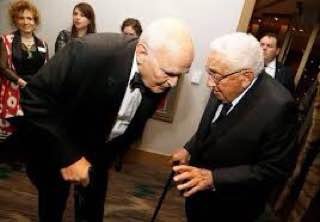
Guido Goldman became very close to Henry Kissinger after the creation of the German Marshall Fund. When Kissinger joined the Nixon administration, Goldman helped him move to Washington. He also regularly hosted gatherings and parties in Kissinger’s honour, including Kissinger’s awkward 50th birthday party just after the Watergate scandal. He also spent most of his weekends with Kissinger. Goldman’s relationship with Kissinger did not travel in one direction, Kissinger reportedly called Goldman to the White House for help with everything from political advice to interior design. In Guido Goldman: Transatlantic Bridge Builder, Klignst writes: “Among Nixon’s close associates in particular, said Goldman, some ‘hated the German Jew from Harvard’ and were determined to make life difficult for him. Kissinger often felt alienated and alone, and he needed a friend he knew he could trust absolutely. Goldman became his close companion.” Later in the biography, Klingst also writes: “Kissinger says his friendship with Goldman was extremely valuable because Goldman never asked for a quid pro quo. Of course, sometimes Kissinger did Goldman a favor, giving a boost here and there to one of Goldman’s projects. ‘But Guido never asked for that, he didn’t even expect it from me.’”
The GMF was surrounded by some of the most influential people in American history, Guido Goldman himself had the likes of Kissinger and Brzezinski as his allies, as well as Establishment elites such as David Rockefeller and John McCloy on standby. The German Marshall Fund of the United States was never just a mere grant-making organization at all, and it most definitely wasn’t “non-partisan.”
The GMF After Birth – A Young Global Leadership Machine
In the final years of Kissinger’s International Seminar at Harvard, Abby Collins had been left to run his advanced leadership program by herself. Collins addition to the team suggested that leadership programs were to be a primary focus of the GMF. In 1967, Kissinger’s Seminar had been outed as a CIA funded operation which was training American-aligned leadership candidates from around the world and, when it collapsed, Harvard had lost one of its flagship programs. Guido Goldman’s German Marshall Fund were now ready to fill the void at the elite American university and, in 1982, the GMF founded their “flagship leadership development program” called the “Marshall Memorial Fellowship (MMF).”
The GMF as an organisation has three defined “pillars”: as a think-tank; as an organization focused on civil society engagement in Eastern Europe; and as the centre for leadership programs. The MMF was created to be, as Klingst puts it in Guido Goldman: Transatlantic Bridge Builder, “the crown jewel” of the GMF’s activities and was launched to “introduce a new generation of European leaders to the United States.” Unlike many other leadership-focused organisations, the MMF’s 2,500 alumni continue to commit to GMF-related engagements throughout their careers. Every year, the MMF “prepares around seventy people for leadership roles” in both Europe and America. The program aims to create future leaders in politics, business and civil society, with some advancing to the highest levels of political and corporate life.
Some of the advertised alumni include Stacey Abrams, who served in the Georgia House of Representatives and has unsuccessfully run to be governor of that state, and the Hungarian prime minister Viktor Mihály Orbán. As the GMF was launching its first leadership initiative in 1982, they also began hosting an event called the Multiplikatoren Seminar (Multiplier Seminar), which was later rebranded as the Manfred Wörner/Euro-Atlantik Seminar. The seminar was co-sponsored by the GMF alongside the Armed Forces Office of the German Defence Ministry. The Manfred Wörner/Euro-Atlantik Seminar still runs annually and “brings together 30 young Americans and Europeans from a diverse range of professional backgrounds to examine German and European security policy and discuss US-German and US-European security interests.”
The GMF’s leadership programs offer grants, fellowships, distance learning and more, alongside allowing their fellows access to the 4,000 alumni based throughout Europe, the United States, and what the fund describes as “partnership countries”. There is more than two leadership program run out of the GMF, as well as the aforementioned Marshall Memorial Fellowship and the Manfred Wörner Seminar, the GMF also run the Transatlantic Inclusion Leaders Network, the Policy Designers Network, and the Leadership Lab. According to the GMF’s website, the current head of leadership and democracy initiatives for GMF’s Leadership Programs, Ana Aelenei: “manages two fellowship programs for leaders from Armenia, Georgia, Moldova, and Ukraine.” In 2012, the Transatlantic Inclusion Leaders Network (TILN) fellowship was founded by the GMF to be what they describe as an: “Empowering program for young diverse elected leaders, with select civil society and business leaders, who collaborate, peer mentor, and educate each other in working to advance inclusive policies and strengthen social cohesion.” The GMF boast that: “The TILN network has more than 200 alumni advancing to higher office including the European Parliament and US Congress, among other roles.” The Leadership Lab and Policy Design Network are again both programs designed to focus on Armenia, Georgia, Moldova, and Ukraine, in particular.
In the late 1980s, like other wealthy funds, foundations and trusts which were focused on Eastern Europe, the German Marshall Fund was observing the fall of Soviet Russia in real-time. During this tumultuous period in modern history, the GMF examined the events which were unfolding in the region closely. One of the main purposes of the GMF was to create American-aligned leadership candidates to replace the Soviet-aligned leaders as Soviet-style communism had been defeated. Whereas Kissinger’s International Seminar had cast a wider net, recruiting and training pro-US leadership candidates from all around the world, the GMF’s leadership programs were specifically targeting Eastern Europe.
The people at the upper echelons of the GMF have often been the same CFR-members who were found walking the corridors of power in Washington DC, and this has been a major theme from the organizations inception. Willy Brandt’s involvement in the creation of the German Marshall Fund did not end with its founding. He was also chosen as the first president to lead the GMF, but instead asked Benjamin H. Read to fill the position. Read had been serving as the Director of the Woodrow Wilson International Center for Scholars (Wilson Center), a position he had held since 1969. Previously, Read had been executive secretary for United States Secretary of State Dean Rusk and had also worked for Vice President Hubert Humphrey during his 1968 US presidential election campaign. Later in his career, President Jimmy Carter nominated Read to be Deputy Undersecretary of State for Management. He was promoted to the position of Under Secretary of State for Management a year later. Read was one of the State Department members focused on the freeing of the hostages during the Iran hostage crisis of 1979. He was also the president of Ecofund ‘92 and was a driving force behind the 1992 Earth Summit in Rio de Janeiro. After his government service, Read spent most of his later life working for modern international environmental organizations.
After two years of service, Benjamin H. Read was joined at the German Marshall Fund by Robert Gerald Livingston. The latter had been a Visiting Fellow at the Council on Foreign Relations where he was involved in a study group focused on Germany. Livingston left the CFR study group in 1972 after being offered a position as part of the national security staff under Henry Kissinger. After serving in Kissinger’s State Department, he became the vice president of the GMF and later served as the GMF’s president from 1977 to 1981.
In March 1974, during the frenetic reporting on the multifaceted Watergate scandal, the Green Bay Press-Gazette reported on Jill Ruckelshaus’ resignation as White House Women’s affairs adviser. Ruckelshaus’ husband had previously been dismissed from the Justice Department the October prior after he refused to fire the special Watergate prosecutor, Archibald Cox. Mr. Ruckelshaus went on to hold a senior position at the German Marshall Fund, where the aforementioned article states:
“Mr. and Mrs. Ruckelshaus were guests in Kenya of Maurice Strong, executive director of the Nairobi-based United Nations environment program. Ruckelshaus, head of the German Marshall Plan Fund, a West German-financed foundation with environmental interests, is discussing possible joint programs with the UN agency.”
Maurice Strong had a significant impact on the politicians of the era in relation to the creation of the modern environmentalist movement. The aforementioned Benjamin Read also had ties to Maurice Strong, and worked for him when Strong was the The United Nations Conference on Environment and Development (UNCED) Secretary-General. Strong also had ties to a now infamous Harvard graduate of Kissinger’s International Seminar, Klaus Schwab, eventually going on to become intimately involved with the World Economic Forum.
In 1974, as R. Gerald Livingston is leaving Kissinger’s Whitehouse team, the GMF began financing the first media initiatives targeting Europe. While referring to how the GMF intended to use the German funding, a Chillicothe Gazette article from 1974 states:
“The board has selected three areas for the first projects: (1) Support will be given to a 30-month international comparative land use project. (2) The fund will support efforts in the communications field to increase the international exchange, adaptation and use of TV program materials about significant, contemporary problems of common interest; (3) Also, the fund will attempt to assist the transfer of advanced technical and organizations capacities in the fields of resource recovery and certain urban services.”
In 1974, the GMF funded its first media initiative called “Bill Moyers’ Foreign Report”, a TV series on international affairs which starred the former-Whitehouse Press Secretary under Lyndon B. Johnson. Described as a journalist and political commentator, Billy Don Moyers was also director of the Council on Foreign Relations from 1967 until 1974. The project with Moyers received around $1.5 million in funding from multiple sources, including the Ford Foundation and IBM each contributing $100,000, The Corp. for Public Broadcasting gave the project $200,000, while the GMF gave $500,000 to see the project manifest. The Moyers project was to begin by producing four documentaries studying: the developing islands of the Caribbean; the economic progress happening in Mexico; the problems in Japan’s economy; as well as an interview with the West German Chancellor, Helmut Schmidt. By the following year, the GMF sponsored “Moyers’ Journal: International Report” was airing weekly. The 17 January 1975 edition featured an exclusive interview with none other than Henry Kissinger. In addition to financing media production, the GMF was also funding talented young people to study in West Germany and beyond, such as Rudy J. Koshar Jr., a graduate from the University of Michigan who gained a summer grant to study German in West Germany. The GMF also gave grants for European students to visit America to people such as to Miss Jacqueline Nonon in 1977, a French representative of Women’s Affairs Bureau of the European Economic Community.
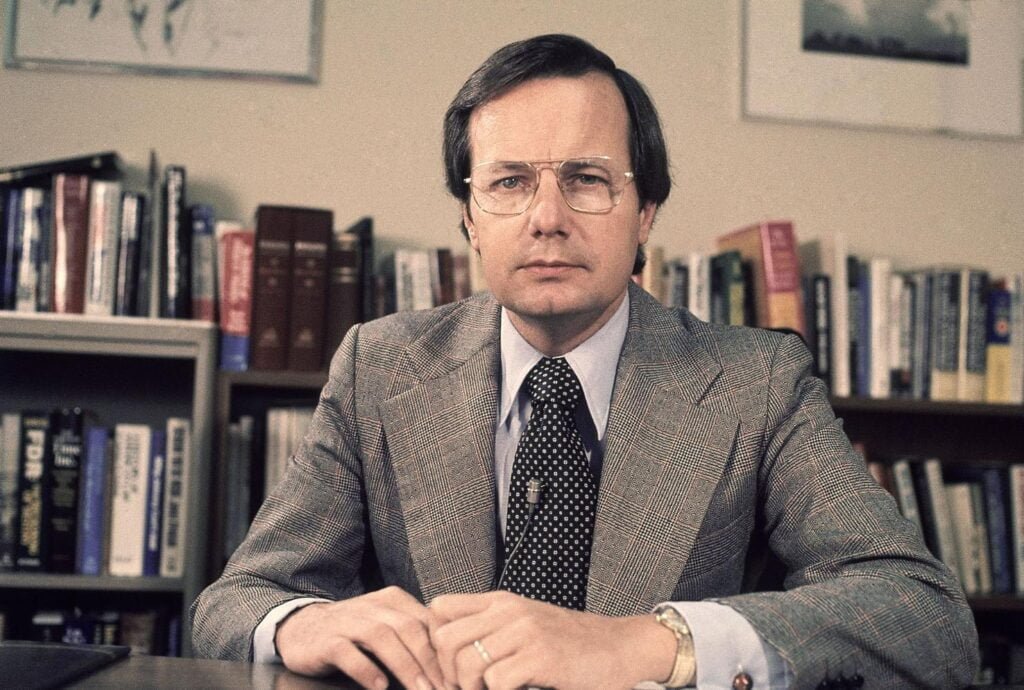
In 1976, the link between the GMF and those in politics was clearly observed when President Jimmy Carter was rumoured to be wrestling between choosing a new national security advisor, with the choice being between the GMF’s President, Benjamin H. Read, and one of the President Carter’s long-time supporters (and a former tutor to Guido Goldman), Zbigniew Brzezinski. Eventually Brzezinski was announced as President Carter’s National Security Advisor with Read instead becoming Deputy Undersecretary of State for Management in July 1977. In October of the that year, the GMF was also supporting what the press described as a “high-level conference of economists” under the auspices of creating a better democratic system in Portugal. In 1980, the German Marshall Fund also funded the production of the WGBH/Boston international documentary series called “WORLD” which, like Moyers’ program before it, studied how to redefine the relationship between the United States of America and key strategic partners globally. By the 1980s, the GMF had become a brand of their own and were often referred to in newspaper articles, with their representatives commenting on hot button issues.
The Modern GMF
Initially, the promoted purpose of the German Marshall Fund was to “investigate and compare social problems on both sides of the Atlantic” rather than to be a transatlantic think tank. The remit of the organization soon expanded into other areas. As Max Frankel found out, this “educational institute” was soon waging a secretive propaganda war in Europe. The GMF doesn’t only make-grants, they also fund other societies such as the American Institute for Contemporary German Studies, the American Council on Germany, and the Congressional Study Group on Germany.
In 1971, the year before the GMF was officially created, another Kissinger protégé, Klaus Schwab, had founded the World Economic Forum alongside mentors given to him at Harvard, again by Henry Kissinger.
These Harvard/CFR alumni were not only looking to train up Western-aligned future international leaders, they were also systematically overthrowing anti-American regimes globally. Indeed, it is an open secret that the American national security Establishment have been using Harvard University as a tool in designing and supporting foreign revolutions while also training the leaders of the future who could potentially fill the vacuum of power in any of America’s target country.
The German Marshall Fund was an organization financed by the West German state which allowed the American intelligence apparatus to setup base in Eastern Europe. Organisations such as the GMF have been busily fostering the demand for political change in unstable countries throughout the region, with the intelligence agency backed meddling leading to various “Colour Revolutions,” all of which were followed by externally influenced election processes.
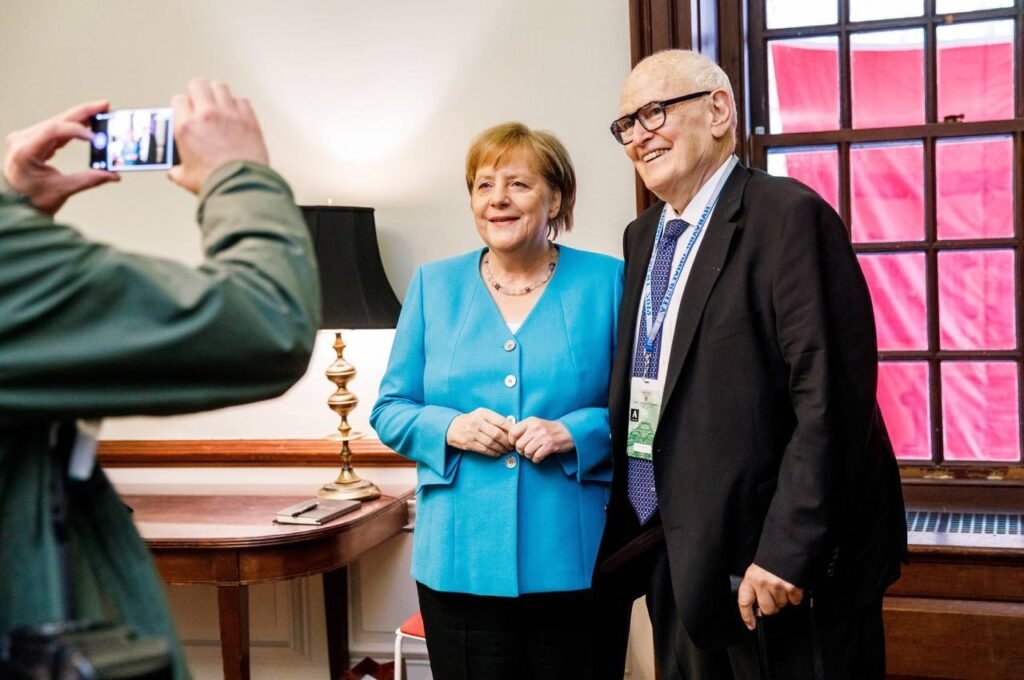
Matters concerning Ukraine specifically are still the focus of the GMF and the organizations relationship with the American national security apparatus has become increasingly more overt. On 1 August 2018, Laura Rosenberger produced a statement to the Senate Select Committee on Intelligence, “Open Hearing: Foreign Influence Operations’ Use of Social Media Platforms,” the statement reads:
“I watched from inside our National Security Council when Russia was test-driving many of these approaches in Ukraine as our government struggled to fully understand and respond to these tactics. And I watched from the campaign trail as our government was caught by surprise that these tools were being used against American democracy ahead of the 2016 presidential election.”
The latter paper examines the social media propaganda efforts of the main rivals to American hegemony, Russia and China, as well as showing us clearly that the GMF’s front lines are about to realign again with the front lines of the Cold War-era propaganda war waged by the German Marshall Fund going increasingly online. Rosenberger made her remarks on behalf of the neoconservative initiative “Alliance for Securing Democracy” which is affiliated with and housed at the German Marshall Fund of the United States and has neocon hawks such as Michael Chertoff, John Podesta and Bill Kristol on the organisation’s advisory council.
Between April 2014 and September 2021, Karen Donfried served as the president of the GMF, later being installed as Assistant Secretary of State for European and Eurasian Affairs in President Joe Biden’s administration. Donfried, who is also a member of the CFR, the American Council on Germany, and the Paris School of International Affairs, became the World Economic Forum’s Member of the Europe Policy Group in 2017 as well as sitting on the WEF’s Global Future Council of the Future of Regional Governance. These sort of glaringly obvious globalist affiliations of key people working in the modern White House have become a cause for concern. Many American voters have started to question the allegiance of their elected officials who are currently holding some of the most senior offices in the USA.
The modern members of the GMF are still some of the leaders of their fields. Like the New York Times’ Washington chief Max Frankel before him, David Ignatius, who writes a twice weekly column for the Washington Post, is one of the representatives of the media who sits on the GMF’s modern day Board of Trustees. He regularly writes opinion pieces about Ukraine in articles such as: “The U.S. seeks to support Ukraine, but contain the war,” as well as writing obvious propaganda hit pieces on other US enemies such as Iran China and North Korea. But, unlike Max Frankel, Ignatius doesn’t shy away from his association with the GMF and the organization’s historic bedfellows including writing a piece on 24 November 2022, entitled: “Why Artificial Intelligence is Now a Primary Concern for Henry Kissinger.” Like many other people who spend part of their life within an element of the national security state, Ignatius also authors spy novels.
Many of the members of the German Marshall Fund have been high-ranking CFR members and Guido Goldman’s links to the Council on Foreign Relations were not just through the many associated members of the GMF. Goldman was at one time the Chairman of the CFR’s Term Membership Committee based out of New York with much evidence to suggest that he was an extremely important member of the CFR. For instance, in a letter dated 1 March 1977, Goldman is found asking the then-director of the Central Intelligence Agency, Stansfield Turner, for his nominations for CFR membership, with his response to Goldman also being documented. It isn’t only Goldman, Rockefeller and McCloy who had pledged their allegiance to the Council on Foreign Relations. Every member of the original German Marshall Fund’s Board of Trustees and most of the Honorary Committee were also members of the CFR, leaving the German Marshall Fund to appear to be nothing more than a round-table grant-making organization loyal to a well-organized US shadow government.
Throughout his career, Guido Goldman was recorded meeting with some of the main movers and shakers involved in policy towards Europe. There was also a concerted effort during this period to reorganize the American and Western European relationship for better policy alignment and Guido Goldman was involved in this reorganization of policy-making efforts. A CIA document from 3 September 1980, addressed to the current-President of America, Joseph Biden, shows Guido Goldman joining Stanley Hoffmann, Robert Lieber, Amitai Etzioni and others, alongside around twenty European specialists from the intelligence and foreign policy communities, for “round-table discussions” entitled: “Policy Issues Between the US and Western Europe in the 1980s.”
In 2014, the now-deceased German writer and journalist, Udo Ulfkotte, spoke candidly about his experience with the German Marshall Fund: “I was invited by the think-tank The German Marshall Fund of the United States as a fellow. I was to visit the United States for six weeks. It was fully paid,” Udo Ulfkotte said during an interview while speaking about his book, Bought Journalist, going on to say: “This think-tank [The GMF] has very close connections to the CIA to this day, they acquired contacts in the CIA for me and they got me access to American politicians, to everyone I wanted. Above all, they showered me with gifts.” The clear connections between the German Marshall Fund and the American intelligence apparatus brings credence to the latter statements by Udo Ulfkotte, who was derided by mainstream German outlets as a conspiracy theorist for stating that there was collusion between the CIA and reporters.
In the second volume of One Nation Under Blackmail, a very interesting connection between Guido Goldman and Jeffrey Epstein is revealed. In the chapter entitled “The Property Developer”, Whitney Webb explains how Guido Goldman purchased 9 71st Street East from Jeffrey Epstein on behalf of Edgar Bronfman, stating:
“In 1992, SAM Conversion Corp sold that property [9 71stStreet East] to 11 71stStreet Trust for ‘ten dollars and other valuable considerations paid by the party of the second part.’ Epstein was listed as vice president for SAM Conversion Corp and a trustee of 11 East 71stStreet Trust. The property was controlled by Epstein until 1996, when it was sold to Comet Trust for ‘10 dollars and other valuable considerations,’ per official documentation.”
Later on, Webb writes:
“Crain’s also revealed that the Comet Trust trustee involved in this sale was a man named Guido Goldman.”
The property in question, owned by the Epstein/Wexner linked SAM Conversion Corp, wasn’t necessarily sold to Guido Goldman for himself, Webb also reveals:
“At the time Goldman, via the Comet Trust, purchased the home from Epstein, the president of the World Jewish Congress was Edgar Bronfman. Crain’s noted that the Comet Trust, where Goldman was Trustee, was one of three trusts established ‘for the benefit of descendants of the late Minda de Gunzburg,’ Edgar Bronfman’s sister.”
Edgar Bronfman is also noted in Guido Goldman’s biography as offering his private plane to fly Nahum Goldmann’s body to Israel after his passing.
Guido Goldman died on 30 November 2020 at the age of 83. He had been born into a family of influence and privilege and, just like his father, he used his skills to help forge new nations. But the German Marshall Fund hasn’t died with its founder. Nowadays, the GMF is more overt than ever before about their meddling in the affairs of foreign democratic elections. Some of the influential speakers who are listed as having talked at GMF events include: John Kerry, Madeleine Albright, Recep Tayyip Erdogan, Condoleezza Rice, Gordon Brown, and Zbigniew Brzezinski.
Guido and his father were similar in many ways, but they were experts in one thing in particular, creating political instability in regions which had been previously stable. Now, as the ideological frontline of America’s secretive political war against the East approaches the borders of Russia itself, the German Marshall Fund moves its players forward accordingly. The pressure they apply will lead to more instability regionally, begetting the further use of limited political warfare techniques.
The German Marshall Fund of the United States website is still busy invoking the memory of the original Marshall Fund, this time in relation to Ukraine:
“The Marshall Plan was an audacious, innovative strategy to tackle the most pressing challenges of its time. Amid Russia’s war on Ukraine, the German Marshall Fund of the United States provides insights, commentary, and analysis on Ukraine’s recovery and reconstruction through the spirit of the Marshall Plan.”
Whenever there is war being waged on Russia’s border, you can be sure that the GMF will be, at the very least, taking detailed notes. However, The GMF takes more than mere notes, they are training a carefully selected group of intelligence-linked potential leadership candidates to join their cause.
The greedy-eyed Western elite are playing a dangerous game. The original goal of such organizations as the German Marshall Fund was to win the Cold War and afterwards new goals were decided upon which led to further pro-American encroachment into destabilised European countries bordering Russia itself. Their tactics were originally implemented strategically to achieve certain ends while avoiding sparking all-out armed conflict. But now, with limited armed conflict manifesting on the ground, continuing to engage in such tactics is more akin to throwing a lit match into a tinderbox, with organizations such as the German Marshall Fund of the United States being the proverbial fire-starter.
Author’s Note: Johnny Vedmore would like to thank researcher Kaan Disli for his help researching this article.
Featured Image: Willy Brandt delivers the Marshall Memorial Convocation at Harvard University, June 5, 1972. Source: GMF Flickr
